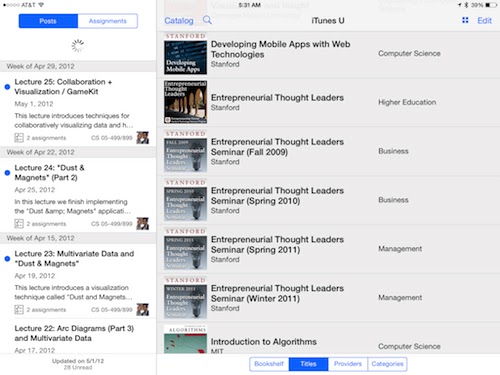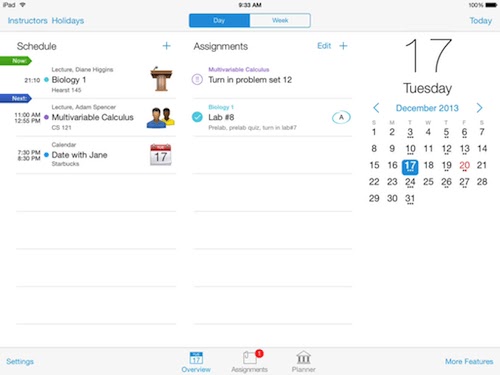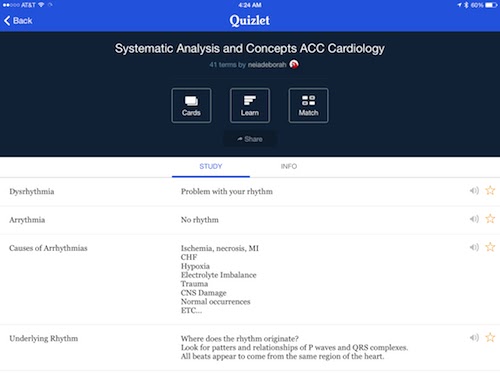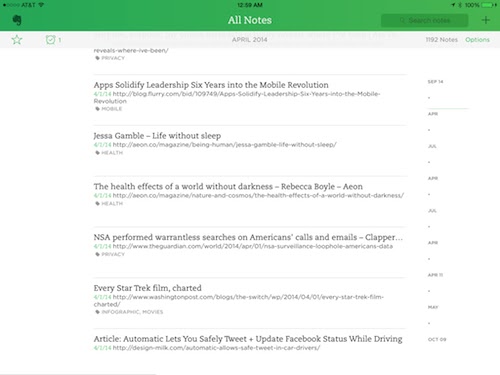We know. You’re a college student, or soon to be. You’re on a budget, but you need study tools to help you get through your courses. Well some of the best things in life are free, and that includes study apps. Whether you are a student at one of the nation’s many traditional or online colleges, these apps will help you maximize your time in and out of the classroom.
While some people might say that your brain is the only study tool you really need, it doesn’t hurt to have some free software to help out. So we’ve put together a list of apps that can help with studies. This list is primarily for Apple iOS apps, though several entries have links for Android, Web, or desktop (Mac OS X, Windows, sometimes Linux). All of them are free, though some might have IAP (in-app purchase) options for advanced features (or sometimes just for getting rid of annoying ads). Occasionally, alternatives are listed, especially when an app is only on iOS.
Notes:
- Screen snapshots of listed apps are of Apple iPad versions unless otherwise indicated.
- These are app feature summaries only, not an endorsement. Please read each app’s user agreement before using.
15. iTunes University
Apple’s iTunes University (iTunes U for short) has a wealth of curriculum course material from many top universities and colleges. Your own school’s course materials might even be on iTunes U, but if not, you might find similar content from the equivalent courses at other schools. The app is only available for iOS, and content is a mix of text (multiple formats), audio and video, depending on the content provided by the course content creator.
Other App Info:
14. iStudiez Lite
Have you been watching too much TV instead of studying? How many times can you watch Breane of Tarr in the Game of Thrones kick The Hound’s backside, anyway? It might be time to map out your semester to organize your course, assignment and exam schedule, and the award-winning iStudiez app can help. The free Lite version allows you to manage one semester of up to five courses, 15 classes/exams per course, 15 assignments, five instructors and two holiday periods, and you can set alarms. If you like the free version, $2.99 gets you the iStudiez Pro version (separate install; not an in-app purchase), which takes away the limits, adds push notifications, backup and other features.
For a student time management app alternative for Android, try Timetable by Gabriel Ittner.
Other App Info:
13. Exam Vocabulary Builder
AccelaStudy claims over 6 million users who have used their Exam Vocabulary Builder app to improve English vocabulary, whether for college freshman/ graduate entrance exams, professional advancement or for language proficiency. The app uses “spaced repetition” to help with retention. In addition to search and organize features, there are several modes, including Study, Flashcard, and Quiz. This app is particularly useful to ESL/ TOEFL students for whom English is not their first language. Note: iOS-only. An Android alternative is GRE Vocabulary Builder by Magoosh, who have a number of similar apps for iOS.
Other App Info:
12. Dictionary.com
Vocabulary builder apps are fine for prepping for exams, but they typically have a limited set of words. Enter Dictionary.com for all your English learning needs, with 2,000,000 definitions. The main app is free (with ad banners) and has search history, word origin and history, Word of the Day, synonyms, antonyms, a thesaurus and more. In-app purchase options include a medical dictionary, encyclopedia and more. The iOS version has accumulated over 43,000 ratings on all version for a total of 4.5 stars — which pales in comparison to the 610,000-plus ratings for the Android version.
Other App Info:
11. Skype
Sure, you thought Skype was just a communication app. But because of that and its features (text chat, voice chat, video, file sharing), it can also be a study app. When it’s late, or cold outside or you’re studying last minute for an exam and need something from a classmate, Skype can be your saving grace. Sure, they could email the scanned notes to you, or share it over Dropbox, or use the lame “virtual classroom” software that your college has, but Skype lets you chat with them while they send you the file. And when the file has downloaded, your pal can help you decipher their horrible handwriting scrawl so you can actually use the notes. (You might recommend that they try the MyScript Smart Note app (#3) for their terrible handwriting.) Alternately, if you a tutor who does not make house calls, Skype is the next best way to have a tutoring session. Note: iPad version separate from iPhone version. Desktop versions downloadable from the main site.
Other App Info:
10. Coursera
Here’s a crazy thought: succeed in college by creating more homework for yourself. In some countries, there are statewide or country-wide exams, and it’s too bad for you if your college professor “didn’t teach that.” It’s your responsibility to know a subject. While this does not happen in the U.S., what if you took the same attitude of responsibility for your own knowledge and put in some extra effort? You don’t have to be a study-masochist to get an advantage from this effort. Coursera.org is an online education site that has partnerships with many dozens of top colleges and universities in the United States, including Ivy League schools. These schools offer both curriculum course study materials and MOOCs (Massive Open Online Courses).
Sign up, study at your own pace, and supplement your knowledge for that extra advantage. You can use Coursera’s Web site or mobile apps to to study a selection of courses and supplement whatever you are learning at your college. Even better, use Coursera to introduce yourself to subjects before you enter college each semester. Because wouldn’t it be nice to ace your actual courses, get on the Dean’s Honor List, win awards and maybe a bit of extra scholarship cash?
Other App Info:
9. Google Drive
Take notes, draw diagrams, create spreadsheets, build presentations and keep them all in the cloud, accessible from an Internet-connected computer or mobile device when you need them.Google Drive is a collection of cloud-based “Office” apps that includes capabilities for spreadsheets, documents, presentations, diagrams and more. Google also provides each Drive account with probably more than enough cloud storage for the files of an average college student. But if you run out, you can pay for more. Drive’s collection of apps are Web browser-based, though there are iOS and Android versions, linked below. Sign up free with an email address; automatic if you have a GMail account.
Other App Info:
8. Dragon Dictation
Do you have study notes to type up for an overdue class project and your poor fingers are so tired from flipping through those ancient things called print books? Or maybe granny is paying for your college and you need to get your weekly email out to her fast, and your typing sucks. No problem. Just start talking into Dragon Dictation and it’ll convert everything for you digitally, which you can paste into other apps, send as an email message, or save it for later. Save your fingers for texting. Actually, you can use Dragon Dictation for text messages as well — at least the kind where you need to type entire English words in full. Note: iOS only. Nuance has Dragon apps on Android, but not this one.
Other App Info:
7. Brainscape – Smart Flashcards
Brainscape has a number of flashcard style apps for iOS. One such is “Brainscape – Smart Flashcards,” which is bill as being “brain games to study Chinese, SAT and more.” Create your own flashcard sets or download from the Market (has both free and paid content). It’s relatively easy to use, easy to create flashcard sets with, and free (if you don’t mind ad banners). Brainscape also has the the Flashcards*/ Flashcardlet app which can access content created with the main Brainscape app, in a less distracting environment (albeit also with ads; both apps charge $2.99 to get rid of ads).
Other App Info:
6. Flashcards+
Flashcards+ is not just another flashcards app. It’s an app by young serial entrepreneurial and wunderkind Connor Zwick, who started making waves at 13, was simultaneously accepted to startup incubator Y Combinator and Harvard in 2011 (at 18), and who left Harvard at 19 to take advantage of a Thiel Fellowship with a $100K grant. While he’s supposedly concentrating on a mobile phone game controller, he has also produced the Flashcards+ app for iOS, which passed a million downloads by some time in late 2012. The app has a one of the cleaner interfaces for this category, and with nearly 47,000 ratings and an average of 4.5/5 stars, it has a lot going for it. Features include pronunciation help for 22 languages, millions of decks accessible from the Quizlet app (#4 in this list), deck shuffling and more. In-app purchase options include multiple male/female voices for pronunciation help.
Other App Info:
5. Quizlet
Quizlet, a general study tool, boasts millions of flashcard study sets for numerous topics, created by student users (high school and college). If you can’t find the subjects you’re looking for in such a large collection, you can of course make your own. Quizlet also lets you use images and audio in your flashcard sets, which adds variety to the learning process. Quizlet has support in other flashcard study apps. So even if you create study sets now but later switch to flashcard app that supports Quizlet, you can reuse your content — or anyone’s shared Quizlet content.
Other App Info:
4. Todoist
If you find Evernote(#1) too intimidating with all its notetaking features and really only want a todo list app, maybe with Web URL bookmarking features, try Todoist. Sure there are dozens of todo list apps, but Todoist is arguably one of the best, and it’s one of few that does project/ subprojects and tasks/ subtasks well. Use it track your course assignments, set reminders, bookmarking Web pages you visit and more. Combine the Mobile app with a Web browser plugin for optimum use. Todoist also has Mac and Windows desktop versions, Chrome and Firefox browser plugins, and plugins for Outlook, GMail, Thunderbird and Postbox email clients. Paid version (subscription) includes unlimited projects and tasks and other features.
Alternatives to Evernote include Pocket for bookmarking and Wunderlist for todo lists — both on browser and mobile, plus desktop editions for Wunderlist. Do you have a budget for some mobile apps, and want something more sophisticated for advanced todo lists or light project management? Drop an Andrew Jackson ($20) minus a Lincoln penny and you can have a much more sophisticated app called “Things for iPad”. There’s also a version for Mac desktops.
Other App Info:
3. MyScript Smart Note
If you’re the type of student who prefers to write down notes in class instead of typing (or borrowing notes later) and wished it were as easy to write on a tablet as on paper, you’ll have to wait a bit longer. Sure, there are a dozens of “notebook” apps that allow you to handwrite with a finger or stylus, but none are really suitable for the speed with which class lectures would require. However, if you want an app that should suffice for taking notes on a tablet while studying in the library or your dorm room, then MyScript Smart Note is an excellent start. After trying out close to a dozen similar apps, we’ve decided that none seem to recognize handwriting as well Smart Note — and in multiple languages, no less.
The app is available free (but with limited features) for both iOS and Android, and while the two versions are slightly different in functionality, both have the kind of killer features you want in a note-taking app, namely quite impressive handwriting recognition abilities, often even with a scrawl. Even if your handwriting is mostly legible, Smart Note is pretty accurate in understanding it. On the Android version, you can have the handwriting converted and replaced by the digital equivalent, so you can easily see what the app thinks you wrote. Unfortunately, that’s not true for the iOS version (except in the search mode panel). However, both versions do recognize handwriting and allow you to search. (Note: you made need a suitable stylus.)
If that’s not enough, the app allows you to edit your handwriting with special gestures. There’s also an adjustable palm-rest feature, a drawing mode, and you can insert media such as math equations, images, sound or PDF files from various cloud storage services including Dropbox and Evernote (#1). There are also dozens of language packs downloadable for free. If you need more notebooks, unlimited pages, export ability, backups, and more, you’ll need to drop a few dollars ($1.99 for iOS, $2.71 for Android). Check MyScript’s home page for additional apps, including for math and music, as well as for Android phones. (NOTE: snapshot above sourced from iTunes profile of Smart Note.)
Other App Info:
2. XMind
If the “radial thinking” paradigm of mind mapping suits your workflow (try it), then this is an ideal method for note-taking and studying. One of the best free mind mapping apps around is XMind. Unfortunately, it only runs on desktops/ laptops — Windows, Mac, Linux: no mobile apps, no Web apps. However, if you have access to desktop/ laptop computer, you can use it as a planning tool, for projects, for studying. If you’re willing to give up mobility using a desktop-only app, you’ll get an incredibly robust research and study tool that has enough features in the free version alone to cover at least a quarter of the apps in this list, maybe more. You will have to pay for cloud storage — XMind has a subscription service.
Since XMind is free and feature-packed, it’s worth a try — even if you have never used a mind mapping tool. There are paid versions of XMind, which offer additional business-level features, but the free version should suffice for the average student. The Web site has a gallery of hundreds of mind maps that users have shared, to give you an idea of how much you really can do with this free desktop app.
For people who swear by mind mapping and don’t want to pay several hundred dollars for similar functionality, XMind is a good choice. You could try mind mapping mobile apps, but you’ll probably find like we did that some apps are better on the desktop — although if you insist, there’s the free SimpleMind app for iOS (iPhone/iPod Touch and iPad) and Android.
Other App Info:
1. Evernote and Penultimate
Evernote is the king of note taking apps, with a feature set that combines bookmarking, composing, clipping and more. You could even use it for todo lists, if need to ditch all the todo list apps taking up space on your mobile device. If you really had to pick just one app for you study kit, it should be Evernote. It’s available on multiple platforms, usable in Web browser and mobile apps, comes with Web browser plugins/ addons, and it’s all free.
If money is burning a hole in your pocket, you can upgrade and get more storage space for your documents. If that’s not enough, Evernote announced two new features for release some time in fall 2014. One is Work Chat, and it’ll let you text chat with other Evernote users, obviously including classmates. If this isn’t *the* study app that all college students need, then we don’t know what is.
If you install the iPad version of Evernote, add the Evernote Peek (iOS app only) for the ability to do distraction-free, flashcard-style quizzing on question sets that either you create, or download from shared content.
Other App Info:

























